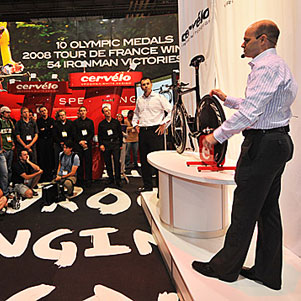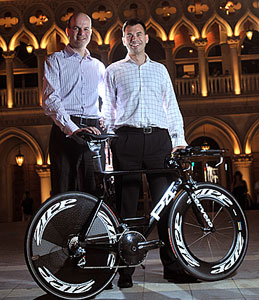Will the credit crisis affect the bike business?

The bicycle business, at least at the upper end, tells itself that it's a recession-proof industry. This doesn't mean it's not a cyclical one, just that the cycles of boom and bust, at least in the United States, are less closely associated with successive bad quarters of GDP than successive bad performances of Americans in grand tours.
Nevertheless, this economic crisis is worth considering, even for a niche as insulated as this one. Yes, end-users are feeling the pinch, because this recent Wall Street temblor hits just the sort of demographic that triathlon draws from. In a current poll on the Slowtwitch Reader Forum, 564 respondents answered a question about the Wall Street Crisis. Only 38 percent said they were unaffected. Fifty-three percent said they were touched, but not overwhelmingly. Three percent lost their homes. Five percent reported that they lost their fortunes.
Consider that there are perhaps 300,000 triathletes in the U.S., and maybe 500,000 if you consider passive triathletes, that is, people who still consider themselves triathletes even though they may not have raced in a year or more. Extrapolating from this poll, it's staggering to think that 40,000 of them have lost either their homes or their fortunes.
That's on the end-user side. What about on the businesses that produce the goods we buy? Triathletes are, one assumes, more in tune than the average bear when it comes to the issues at stake. Chief among them is the availability of credit, and even if Congress passes a bill that will serve to shore up banks and provide liquidity, money is sure to be tight. How will this affect the bike business over the next season? We asked several industry insiders. First, some background…
The biggest companies, those like Trek, Specialized, Giant, Scott, all offer generous lines of credit to their retailers. Local bike shops make their money by heavily leveraging their equity. A shop that sells only $1.5 million a year may live from one season to the next by exercising $500,000 in trade credit extended to it. A Trek or a Felt cannot back up its truck and unload $200,000 in inventory in the dead of Winter and expect that retailer to pay cash. No, that retailer may pay this trade bill on May 1 or so.
If you consider how many retailers these flagship bike companies have, that's a lot of credit they're extending. How do these companies extend that amount of financing? It depends on the company, and what I'll write below is not specific to any large brand mentioned herein. I'm speaking about industry norms.
Most large companies like this must resort on lines of credit that run into the tens and even the hundreds of millions of dollars. For credit lines of that size, it's often a consortium of banks or investors, managed by a lead bank, that pool capital which, in the aggregate, is sufficient for a bike company's needs.
But these companies do not need to rely solely on this borrowing vehicle. Each of them has at least one large offshore partner. In the case of Trek, it is a very strong company, but it also has a strong partner in Giant. Specialized has a strong partner in Merida. These are Taiwanese powerhouses which, because they are located far from Wall Street, are to some degree removed from the problems of Wall Street.
These large companies, particularly if they are well established and are not on an especially steep growth trend, have good balance sheets to present to their banks. Most have a 1:1 or better debt-to-equity ratio. None ought to find it hard to obtain or keep their credit lines.
But these are large companies, each selling in the hundreds of millions of dollars per year. Smaller companies are going to have a tougher time in this lending climate. "For the first time in awhile, I think the barrier of entry to the bike business just went up," said Scott Montgomery, VP and general manager of Scott USA. These mid-level brands—any company between $10 million and $100 million in annual sales—must be very strong in order to prosper in the near term. Some will fail, others will be absorbed by larger companies, just as is now the case with financial firms. "There is going to be some consolidation," said respected industry analyst Bill Fields.
This follows a pattern of bike business consolidation throughout the decade. "We've had a lot of brand consolidation over the past 8 years, and a contraction of retailers," said Advanced Sports' (Fuji America, Kestrel) Pat Cunnane. "We've gone from 6000 to 4200 retailers since the turn of the decade."
This is not necessarily bad news. The industry may have prepared itself in advanced for the current business climate. "The bike industry has already taken its lumps," said Cunnane. "It's in a stronger position to weather the storm."
Advanced Sports itself has a strong relationship with a Taiwanese factory, Ideal Bike Corporation. What does a partnership like this mean, in practical terms? While these relationships vary company to company, just as U.S. bike brands lend trade credit to their retail customers, Taiwanese and Chinese partner-factories lend trade credit to the brands, to help get them over each season's hump.
Cunnane, Fields, Montgomery all said essentially the same thing: The brands with strong balance sheets, and those which are creditworthy, will not have problems. But the more marginal businesses, and those that've grown too fast, and grown on the back of credit, and are highly leveraged, they'll be among the businesses to find it a rough go.
One way the mid-sized brands extend credit to retailers is to borrow on their accounts receivable (A/R). Such lenders are sometimes called "factors," and these companies not only lend against the A/R, they insure the A/R against default.
One mid-sized company in strong shape is Cervelo. Its president and co-founder, Gerard Vroomen (pictured at the P4 Interbike launch), must consider not only his company's credit availability, but that of his direct customers, that is, the retailers. Vroomen says that "A/R insurers are conservative right now, credit limit increases that would have been a no-brainer last year now see more resistance." This means factors are going to be scrutinizing retailers much more closely than in times past, much like mortgage lenders' posture toward prospective homeowners.
But Vroomen does not see this as a problem for a brand with Cervelo's strength. "For us it seems to be business as usual, only more. Dealers are very bullish about their Cervelo business for 2009 despite the credit crisis, the level of their enthusiasm has surprised me."
He is more sanguine about the marginal brands. "I would presume that the second and third tier brands may have trouble keeping their levels at the stores."
Bill Fields echoes this: "There won't be as much product on showroom floors."
What does this mean for end-users? If a store's second, third and fourth brands tend, in general, to have restricted access to credit, or if the stores themselves find their small business credit lines constricted, or if their vendors' factors don't approve them for credit, or tighten their availble credit, they'll forced to do business with less inventory on their showroom floors. The brands that can backfill empty floor space will have see their fortunes rise. Any brand that can fulfill on an at-once basis will have a good year.
This means it should be a banner year for the larger or stronger brands, and for the custom bike makers. It also means that the available inventories on showroom floors will go quick. So, if you've got a Kuota Kueen K, a Scott Plasma II, a Cannondale Slice or a Cervelo P4C in mind, don't think too hard or wait too long.


